Validation
March 4th, 2011 is a day that will forever live in Five Rows lore. It is the day our roadside sign was stolen. We put it out in the morning and it was gone at the end of the day. That hand-painted little red sign has probably helped sell more wines than I have. I hate to see it go.
But this day, the day my sister Catherine turned 30, had an interesting and unforseen twist in store. Later on that evening at the Cuvee 2011 Gala, an annual competition celebrating the best in Ontario wines, our name was called in two categories: 2nd place for Best Sauvignon Blanc and 1st place for Best Pinot Gris. We were surprised and thrilled to be recognized at such a prestigious event. As longtime Niagara grape growers, Cuvee has always held a special place in our heart. In past years when our friends at Creekside won awards for wines featuring our grapes, it always felt neat to know we played a small role. To win this year with wines that I crafted from our own fruit is a completely different feeling that I’m frankly having a hard time getting my head around.
As a rookie winemaker, I’m always nervous having my wines subjectively judged by others. I make wines that appeal to my palate, but worry they may not always appeal to yours. The fact that Cuvee winners are judged by my winemaking peers gives me an uplifting feeling of validation and acceptance. So many days as a winemaker are spent banging your head off a barrel repeatedly in frustration, that its nice to have a night where your head can swell for an altogether different reason. Don’t worry, my pruning tuque still fit this morning (thankfully it stretches). In all seriousness, I don’t see this award as a pat on the back, but as more of a kick in the ass to keep working hard and striving to get better.
In the days leading up to the Gala I read a couple of reviews from Michael Pinkus and John Szabo that gave me an inkling our wines might have shown well. Both writers felt our 2009 Sauvignon Blanc merited inclusion in their personal Top 5 lists from a pre-Cuvee media tasting. These reviews meant a lot to me, but I still didn’t hold out much hope of bringing home any hardware in a room filled with award-winning juggernauts.
Surprise, surprise.
PS: The irony of losing a sign on the day you win some big wine awards is that people still manage to find you the next day.
A Night To Remember
I want to take the opportunity to sincerely thank everyone who attended our first Winemaker’s dinner this past Saturday at Treadwell’s. It was an amazing night of food, wine and merriment.
James was a great host, as always, and his astute pairings worked out perfectly. He really gave our wines a chance to shine. In the end, we all agreed that we should do this more often!
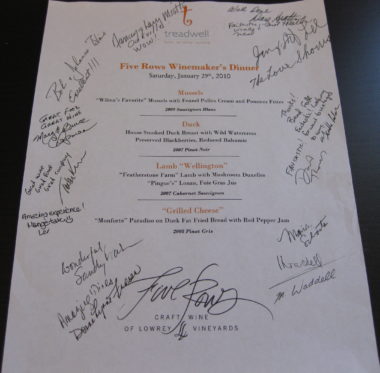
2009 Riesling “Jean’s Block”
We often discuss a vineyard year in terms of the wonderful wines that result. I’ve certainly heard many superlatives thrown around in describing just that from Niagara’s 2007 Vintage. For a change, I’d like to give a different account of 2007, one of extreme vineyard challenges and of personal highs and lows. This is the story of Jean’s Block.
I was blessed on February 24th of 2007 to marry my soulmate. Our honeymoon would have to wait, however, as my hard working new spouse still had some schooling to take care of. Having just moved back from the easy-goin’ east coast, I was about to embark on my first summer at the helm of our yet to be named winery. There wasn’t really any wine yet, just nerves and self-doubt. Were we making the right decision? Am I really a winemaker? There was only one way to find out.
My mother-in-law, Jean Tkaczyk, was always a fan of Riesling. She’d made it clear to me over the years at many lively family dinners that I’d better make her a Riesling one day! I’d always promise her that I would, but there was that small hurdle of not having any Riesling grapes in our vineyard. It was never a variety that our winery clients had desired, so it had never been planted. I fondly remember a trip that Jean, Tanya and I made to Vineland Estates one summer to taste their renowned Rieslings. I quickly became a convert. On that day I was convinced that our new winery needed this variety in its portfolio.
My parents and I decided to plant 14 rows of Clone 49 Riesling on the easternmost part of our farm adjacent to Four Mile Creek. It is a well-drained block, with good airflow and a mixed soil composition of sand and clay-loam. I was well aware that the ultimate challenge with Riesling is keeping the rot at bay, and these parameters would surely help in our efforts. Clone 49 originated in Alsace and is widely considered to be better suited for Niagara-on-the-Lake and St.Davids Bench terroir. It’s known for producing wines featuring floral and tropical fruit notes.
My father spent the spring of ’07 doggedly preparing his field for the coming vines. It was an exciting time. We were off to a hot, dry start to the growing season with all varieties well ahead of schedule. One problem: where were the April showers? They never came. For that reason I’ll always remember 2007 as a challenging drought year more than anything else. We actually had to purchase irrigation equipment! This was unimaginable on a farm that had been bathed with adequate rainfall for five generations. There had been dry years in the past but nothing like this. Maddeningly, it would rain in Queenston and Virgil, but not in St. Davids. It was a bleak prognosis for our soon to be planted Riesling. Young vines need lots of water, and there simply wasn’t enough available in the soil. As the time to plant drew near, however, this was the furthest thing from our minds.
Heartbreak. We lost Jean to cancer that summer. I’ll never be able to understand such things. She will always be remembered with love and her zest for life is still resonant in her children. Her Riesling vines were planted in sorrow.
When I work in Jean’s Block today, three years later, I’m struck by it’s beauty. Not only did it survive the drought of 2007, it thrived. It is without a doubt the prettiest spot on our farm. I’m reminded of Jean every time I look up to see a majestic hawk or encounter a curious cardinal sitting on the top wire. She loved nature and took every opportunity to get her hands dirty in the garden. I’ll never take these earthly pleasures for granted again. My worries magically disappear in Jean’s Block.
The first crack at making wine from this vineyard came in 2009. We harvested about 500kg of fruit on October 25th. The cool ferment was carried out solely in stainless steel with W15 yeast. The wine was left slightly off-dry (14 g/L), but has plenty of acidity to balance the sweetness. We bottled 36 cases on August 30th, 2010.
Bottles #2 through 437 are now available to you. Bottle #1 was put away for someone special. I hope she likes it.
The Best Wines of 2010
Our 2008 Pinot Gris joined some exclusive company recently with its inclusion on a special year end list. You can read about it here.
Treadwell Winemaker’s Dinner
It’s fitting that the first Five Rows Winemaker’s Dinner will take place at Treadwell Farm to Table Cuisine in Port Dalhousie. James and the Treadwell family have been ardent supporters of our wines since they agreed to showcase our very first release of 2004 Unfiltered Cabernet Sauvignon. We’ve come a long way since that initial 12 bottle release, but our vision and commitment to small batch craft wine remains the same.
Not a week goes by that we don’t meet someone who was either directly or indirectly introduced to Five Rows through Treadwell’s. They are a key to our winery’s success and have always been a family favourite place to dine. In fact, my mother made James promise to include her favourite Mussel dish as an appetizer at the dinner. I’ve seen a draft of the menu and simply put – it’s tantalizing. The Treadwell team has chosen four complementary courses to pair with our wines. I’ll be pouring our 2007 Cabernet Sauvignon, 2007 Pinot Noir, 2009 Sauvignon Blanc and the last of our 2008 Pinot Gris.
I encourage all friends of Five Rows to join us for this undoubtedly memorable dining experience on Saturday, January 29. You can find ticket information here. I’m told they are selling fast.
“Abandoned to Dumb Idleness”
I struggle to describe what this time of year feels like for a grape grower. You usually wake up in the morning in a state of panic: what am I picking today? how is the weather? how bad are the birds? are there any leaves left on my vines?
Then reality inevitably sinks in. Your grapes are off the vine and all you’re left with is an empty feeling of no longer being needed. This should lead to a long and relaxing winter, but all those nagging jobs that were left behind during the busy season are still staring you in the face. General clean-up, prepping the ground for winter, hilling up around vines, digging drainage ditches, and installing post and wire into newly planted fields are just a few of these tasks.
The working days are much shorter now and, frankly, so is my level of ambition. I always felt guilty about this annual lack of drive until just recently. I read a book entitled “Outliers” by Malcom Gladwell on advice from my Uncle Don. It was a great read and I was struck by one chapter in particular that described the life of vineyard workers in Burgundy many years ago.
Gladwell quotes historian Graham Robb from his book “The Discovery of France”:
An official report in 1844 described the strange mutation of the Burgundian day-laborer once the harvest was in and the vine stocks had been burned: “After making the necessary repairs to their tools, these vigorous men will now spend their days in bed, packing their bodies tightly together in order to stay warm and eat less food.”
Human hibernation was a physical and economic necessity. Lowering the metabolic rate prevented hunger from exhausting supplies. After the Revolution in Alsace and Pas-de-Calais, officials complained that wine growers and independent farmers, instead of undertaking “some peaceful and sedentary industry” in the quieter season, “abandon themselves to dumb idleness.”
I laughed out loud when I read this because it hit so close to home. The context of this chapter is that we are very much a product of our cultural legacy. So I’m not to blame for my lethargic winter blah’s after all, chalk it up to those who came before me!
2009 Whites
2009 Five Rows Sauvignon Blanc:
Roughly one tonne of fruit was harvested on a beautiful day in early October of 2009. Half the fruit was sourced from our younger, more clay-based block of Sauvignon Blanc, while the other half came from the older vines located in predominantly clay-loam soil. Each block contributes distinct characters to the final blend.
The younger “clay” block tends to be less vigorous, leading to increased fruit exposure and consequently lends the riper, more tropical notes to the blend. The older “clay-loam” block vines are extremely vigorous and require more intense hand labour. Generally they are slightly more shaded, leading to the fresh citrus aromatics and crisp flavours that are classic characteristics of cool-climate Sauvignon Blanc.
As I mentioned last season, the key to achieving the full complement of flavours and aromas is a long, cool ferment carried out in a combination of older French oak barrels and stainless steel tanks. For this wine I opted to go with a two-thirds barrel (2003 Jacques Garnier) and one-third tank fermentation regimen. The tank-fermented portion was allowed to age in oak for a few months prior to final blending. All fermentations were carried out at around 13 degrees Celsius with X5 yeast. 68 cases were bottled on August 31, 2010.
Aromas: vanilla, pineapple, lemon, lime
Flavours: melon, lime, balanced finish
Technical data: 13.1% alcohol, 5.8 g/L residual sugar, pH 3.2
Price: $25/bottle
Production: 68 cases
2009 Five Rows Pinot Gris:
Pinot Gris is quickly becoming a standout varietal in the Niagara Peninsula. Rick VanSickle recently wrote about this trend and chronicled a tasting of 17 different Pinot Gris. Rick was kind enough to purchase a bottle of our Five Rows Pinot Gris to include in the tasting and you can read the exciting review here.
My view is that Pinot Gris is such a labour intensive variety to grow, it better damn well turn out to be a good wine! It would not be worth the extra hand work and stressful pre-harvest nail biting to produce a mediocre, uninteresting wine. “Good” Pinot Gris is without a doubt the most sought-after grape variety by premium Niagara wine producers at the moment. It even has enough clout to be used as a bargaining tool by many growers to help them unload their lesser in demand, easier to grow varieties like Chardonnay and Cabernet Franc.
As is evident in Rick’s article, getting good fruit is only part of the equation. Each winemaker seems to have their own method of coaxing out the best in their Gris. A few years back, a couple of wise Creekside winemakers introduced me to the benefits of fermenting a portion of Pinot Gris in older French oak barrels. I’ve experimented with different oak/stainless blends ever since. The barrel-fermented wine always seems to have weightier mouthfeel and more complex aromatics, so in 2009 I decided to go with a 2/3 barrel, 1/3 tank final blend. I’ve always had good luck with a yeast called R2, so I stuck with it and fermented at the coldest temperature the yeast could tolerate. This led to a slow and beautiful month-long ferment. 70 cases were bottled on August 31, 2010.
Aromas: honey, apple, pear
Flavours: vanilla, melon, spice, left slightly off-dry (1)
Technical Data: 13.0% alcohol, 8.5 g/L residual sugar, pH 3.46
Price: $25/bottle
Production: 70 cases
Both of these wines are now available for purchase at our winery, on our website or can be enjoyed at select licensees. We are happy to announce the addition of two new members to the Five Rows extended family: Ruby Watchco in Toronto and Brookstreet in Ottawa! Ruby Watchco will be carrying our 2007 Cabernet Sauvignon and 2009 Pinot Gris while Brookstreet will be pouring our 2007 Pinot Noir and 2009 Pinot Gris.
A Day in the Life of a Grape Farmer
A Day in the Life of a Grape Farmer
3:30am: Awaken to frost alarm. Fire up the windmill for a few harrowing hours until dawn.
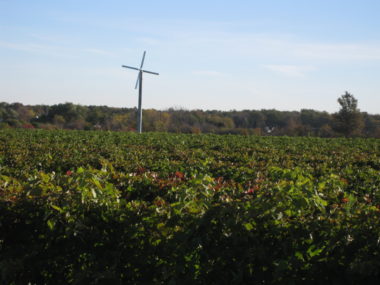
7:30: Groggy Winemaker Son arrives. Exchange pleasantries and play fetch with “grand-dogs”.
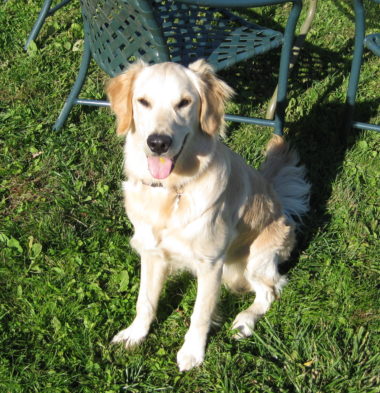
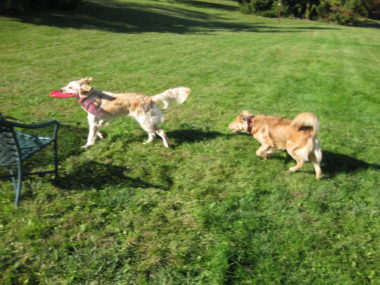
9:00: Dew finally gone, off to hand-pick some Five Rows Shiraz.
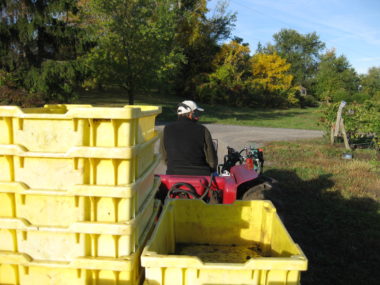
9:03: “Man, they look beautiful!”
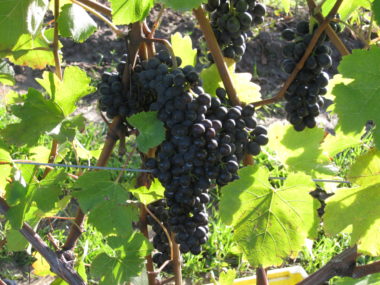
10:30: coffee #5
10:30 – 6:00: A sun-filled, back-achin’ day of quality Father/Son/Shiraz time.
Out With the Old, In With the New
It’s an exciting time at the Lowrey Vineyard. The majority of 2010 fruit has been harvested, and the usually stress-inducing late varieties are ripe already! Summer wine sales have exceeded our initial projections and we’ve sold out of most vintages much sooner than expected. I still have to pinch myself at times to make sure this is all really happening.
I’m continually amazed at the awesome people who happen upon our winery each weekend. It turns out that if you build it, they really will come. They pick me up on rough days and drive my passion to continually push viticultural boundaries. They are always patient when I’ve got a barrel to fill or tank to clean, so I will always try my best to craft wines that keep them coming back.
As the old vintages sell out, I quell my nostalgic thoughts with the early reviews of our 2009s. We’ve been selling a few hastily labelled and waxed bottles of our new 2009 Sauvignon Blanc to a few customers who refused to leave until I could prove to them that this wine was not ready to sell yet. They ended up winning the argument and left with bottles 1 through 12. We are now taking case orders for this wine ($25/bottle).
In other news, we’ve recently made a decision not to actively promote our wines through submissions to wine writers. I’m happy to arrange a tasting for any reviewer at any time, but unfortunately we just don’t have the quantities to send samples to all those who have put in a request. Up to this point in our evolution as a craft winery we’ve relied mainly on “word of mouth” to sell our wines, and I see no reason that needs to change.
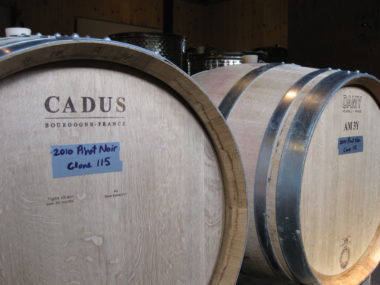
Harvest 2010
Three down, three to go. In one fell swoop, we now have all of our 2010 Pinot Noir, Pinot Gris and Sauvignon Blanc off the vines and in the tanks. All were harvested earlier and riper than in any previous vintage, including the much heralded 2007 crop.
It was a hectic start to harvest this year as all three early-ripening varieties were deemed ready to pick much quicker than anticipated due to rapidly decreasing acid levels. What a difference a year makes! I would like to sincerely thank the skilled crew who helped us painstakingly hand-pick our Pinot Noir. It’s always a challenge to harvest Pinot because every rotten or under-ripe berry must be carefully removed from each cluster before I deem it acceptable. The harvested fruit is then sorted both in the vineyard and at the crusher. This ensures that our Pinot gets off to a good start, with no “off” aromas or flavours in the must. Excess rot can also play havoc with fermentation and eventually filtration.
Just prior to harvest we were able to schedule a bottling run of our 2009 whites, including the much anticipated (at least by my mom) 33 case debut of our Five Rows Riesling. I intend to release these wines sometime soon, so keep an eye on the blog and website. All three of these wines showcase exciting aromatic intensity. I can’t wait for you to try them.
